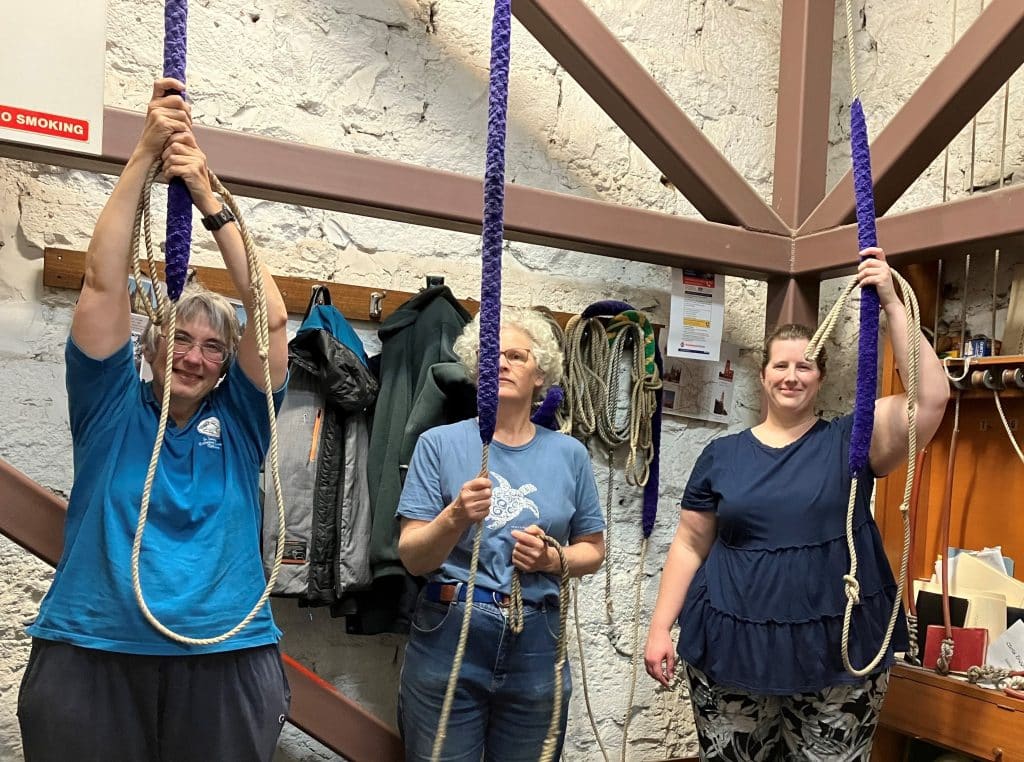
Jenan Taylor
19 December 2022
For many Anglican churches bellringing is still used to call worshippers to services.
Every Friday about five to 10 bellringers climb a narrow, winding staircase to a cosy bell chamber at the top of St James’ Old Cathedral in West Melbourne.
This is where they come to practise manipulating the oldest change ringing bells in Melbourne, either ahead of services or to mark a special occasion, or just because they love it.
Change ringing involves swinging massive church bells in rigorously ordered sequences that generate the kinds of rich notes that traditionally summon people to Sunday services, or mark Christmas, a wedding, or even the funeral of a loved monarch.
The fact that some of the heaviest bells may weigh the same as a small truck usually gives the false impression that ringers need a fair level of physical strength. But mental discipline is more important because ringers have to learn and memorise the order in which their bells sound in relation to all the others in the sequence.
Indeed, in change ringing one person can only effectively handle one bell at a time, so teamwork is key.
In the teams, or bands, as they are called, Anglicans and Catholics, priests and laypersons, LGBTQI community members, Christians and non-believers, young and old people, work side by side, says bellringer Laura Goodin.
“And in Australia there’s a pretty even mix of women and men,” she said.
Read more: ‘Gentler, more inclusive church’: Female priests mark 30 years of ordination
A band member at St James’ Old Cathedral since 2017, Ms Goodin drives every Friday afternoon from Ballarat where she lives and works to west Melbourne for practise.
She thinks nothing of the thousands of kilometres she has covered over the years. Bellringers often criss-cross the city to ring at three or four different towers every week. Many are so devoted, they’ll travel between countries to practise the artform, she says.
Ms Goodin herself fell in love with bellringing after giving it a go while visiting relatives in the United Kingdom. Now she also rings at the townhall and St Peter’s in Ballarat, and occasionally at St Patrick’s in Melbourne, and has gone to the USA and the UK several times to practise.
“Aside from wedding ringing, bellringers don’t get paid for what they do, so it’s a true passion,” she said. “Once they start, they can’t live without it.”
Over in the UK concerns about gender imbalance have been growing in the ringing community in recent years. Many worry that the lack of opportunities for women is turning people away from what many see as a dwindling field.
But Ms Goodin believes the picture in Australia is quite different.
“Australian ringers are a fairly balanced group. I find to my very pleasant surprise that women have leadership positions and roles in towers, and it’s women who invite beginners along,” she said.
Australian and New Zealand Association of Bellringers webmaster Derryn Griffiths has been collating membership and leadership statistics for the two countries and has a few misgivings, however.
Figures Ms Griffiths published in the organisation’s website in April this year showed that women were under-represented in leading roles in Australia.
But she believes the situation is about social conditioning rather than overt sexism.
“I just think we do these little incremental things that eventually end up showing in the statistics,” Ms Griffiths said. “I just wanted to bring that to the attention of the bellringing community in the hope that we can do something to encourage particularly women to flourish.”
Read more: A Christmas service for all who struggle
Association president Thomas Perrin also sees parity as being a part of the Australian bellringing community.
Mr Perrin became involved with bellringing when he was a child and has been doing it for 20 years. “What has been missing is perhaps cultural diversity,” he said. “There are a few people from Asian and Indigenous backgrounds, and so it could be more in line with the range of ethnicities in the broader community.”
While Ms Goodin thinks there is a more even ratio of women to men in Australia than in the UK, she does believe the situation can always be improved.
“Genuine parity is still a work in progress. Women in Australian ringing seem to have more access to leadership positions than they do elsewhere. I’d say we’ve had to be more flexible because we’re more remote from England. So, whoever wants to ring gets to ring,” she said.
She also believes that Melbourne and Sydney towers have a particularly inclusive outlook.
“There are non-binary and transgender band members, and some towers even allow children to learn how to ring. St James’ Old also has a deaf bell ringer, who follows along by watching the motion of the ropes,” Ms Goodin said.
While there are secular towers as well, most bellringing still happens in Anglican churches.
“Many people come to bellringing because it gives them a sense of community, or a skill to master, and they ring for spiritual reasons. For others, even if they do ring in a church tower, it has absolutely nothing to do with religion,” she said.
“Some are just not believers, others have had bad experiences. So, there’s a tension between the religious context in which they are ringing and their devotion to the activity. It’s an individual choice about how they work that tension.”
But on the whole people who are really keen on ringing are sociable and highly inclusive and want others to join them, Ms Goodin said. “That’s another reason they travel the world to do it.”
For her, bellringing is as an expression of her faith.
“I am a believing Christian. I’m a Catholic. And for me, I do personally consider it as an act of service to the people of God as well as something I just plain love to do,” she said.
This article was amended on 20 December to reflect that Ms Goodin also rings at St Peter’s Ballarat, and not the cathedral in Ballarat.
For more faith news, follow The Melbourne Anglican on Facebook, Twitter, or subscribe to our weekly emails.






